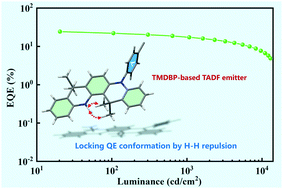A simple and effective strategy to lock the quasi-equatorial conformation of acridine by H–H repulsion for highly efficient thermally activated delayed fluorescence emitters†
Abstract
A novel electron donor, namely, TMDBP is designed by angularly fusing two acridine moieties. The DMAC subunits in TMDBP exhibit a dominant quasi-equatorial conformation due to steric H–H repulsion. The new TADF emitters render excellent OLED performances with EQE up to 24.2% and small efficiency roll-off.



 Please wait while we load your content...
Please wait while we load your content...